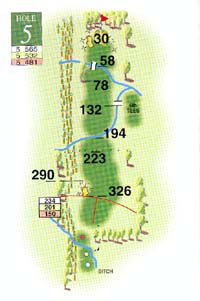
Facing tough par-4s
|
Play the percentages. From a good drive, a 4- or 5-iron into prime position will usually be rewarded with a straight forward 9-iron or wedge approach into the heart of the green. Chances are too that the stroke index is low so you may be facing too putts for a nett birdie.
Long par-4s are typically a low stroke index on the card, too, so if they are out of reach, rather than risking ‘a wide’ into trouble, lay back to an ideal distance for your pitch and two-putt for nett par.
Take more club on par-3s
Most of the trouble around short holes is found at the front or the sides – waiting to catch the miss-hit, the pull or the slice under pressure.
Taking one more club for the distance identified on the card will help ease the tension and enable you to strike the ball sweetly to the back of the green.
And with fewer pitch marks at the back, the grass will be smoother to accept your approach putt.
Take your punishment
How many of us has a GCSE or an ‘’A’ level in hindsight? Most of us, if we’re honest.
So why bore people in the bar with ‘if-only’ stories? They’re not interested, believe me. You only have to look for the tell-tale signs of yawn stifling.
When faced with a shot demanding a miracle escape through a tiny gap in the trees or a penalty drop – take the latter. Take your punishment and get back into play. Often you’ll be amazed how good it makes you feel if you can salvage something from what previously looked a lost cause.
Use local knowledge. Get a pro to mark your card
How many of us, when we visit a new course, ask for advice from the guy who charges us our green fee? Less than one per-cent I’d imagine.
Chances are you’ll be speaking to one of the pro’s assistants, who plays the course everyday of his or her life. There’s nothing they don’t know.
So, if they’re not too busy, ask them to ‘mark your card’ – trouble to avoid, speed of greens, misleading slopes, when to take an iron off the tee. Takes a few seconds but could be worth at least two or three shots over your playing partners.




